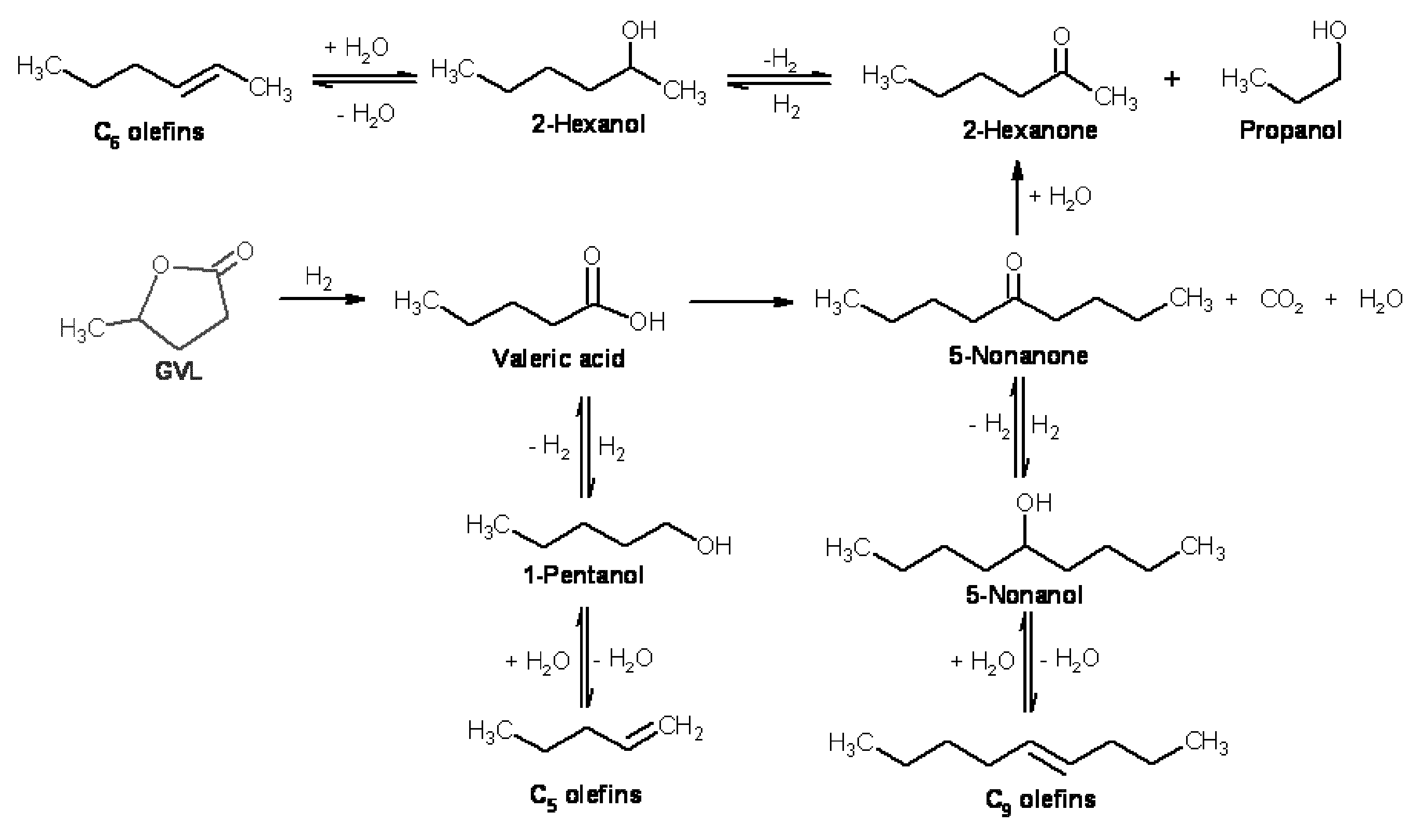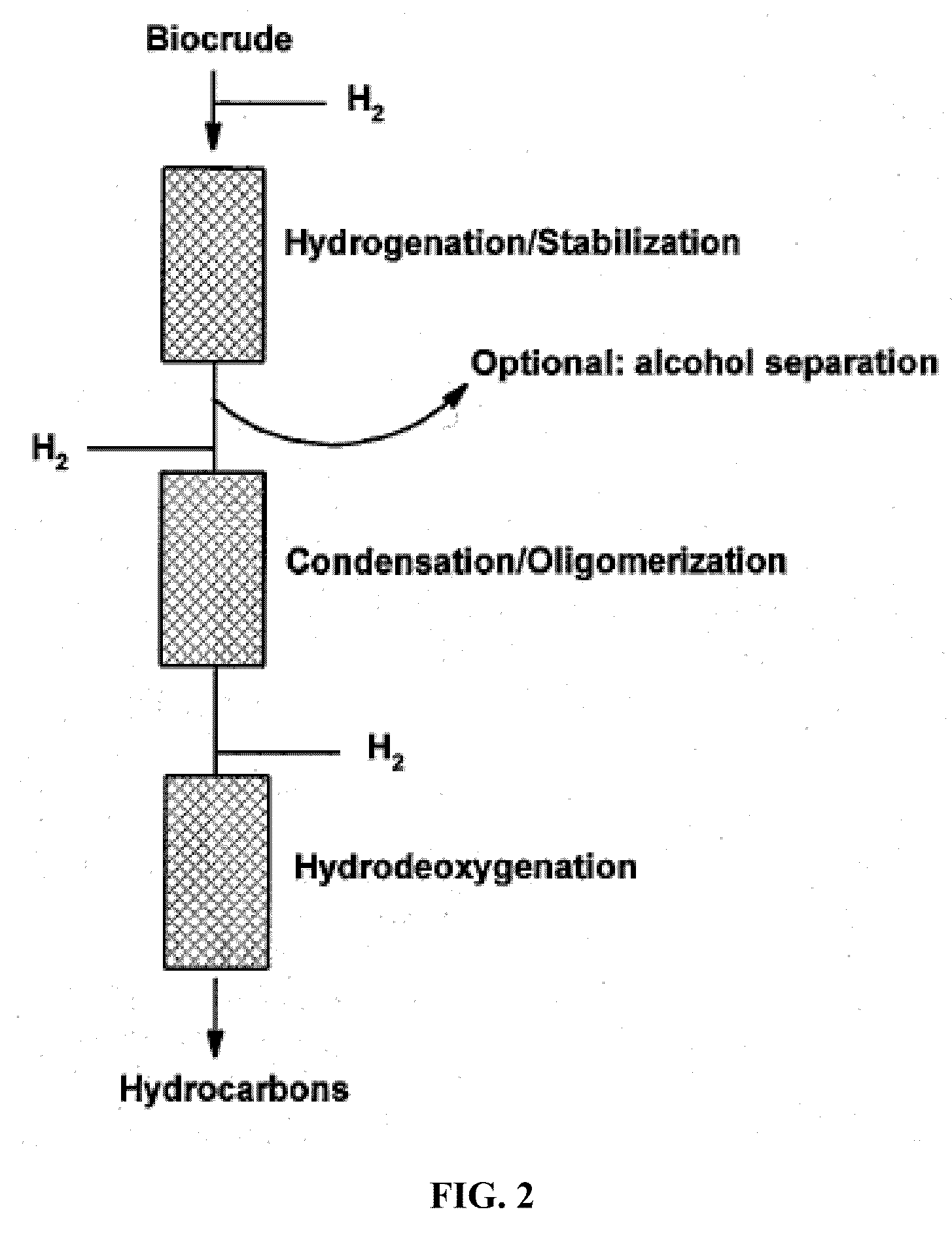Transportation fuels from biomass oxygenates
a technology of transporting fuels and oxygenates, which is applied in the direction of hydrocarbon oil treatment products, metal/metal-oxide/metal-hydroxide catalysts, physical/chemical process catalysts, etc., can solve the problems that most biofuels cannot be used as gasoline substitutes and the synthesis of hydrocarbons from biological sources is limited
- Summary
- Abstract
- Description
- Claims
- Application Information
AI Technical Summary
Benefits of technology
Problems solved by technology
Method used
Image
Examples
example 1
50% wt Levulinic Acid
[0051]Levulinic acid as a 50 wt % solution in water was fed to a packed-bed reactor containing a 5 wt % Ru / C catalyst at 100° C. 400 psig (H2) and WHSV=0.5. Table 1 shows results for the experiment.
TABLE 1Results from the hydrogenation of levulinic acidon Ru / C (unidentified products are not shown).% Levulinic% YIELDacid1,4-2-2-ProductconversionGVLPentanediolButanolPentanolDay 199.846.88.421.441.4Day 299.762.512.972.93.3Day 399.860.112.33.54
[0052]The Ru / C catalyst was stable under the reaction conditions. Levulinic acid was converted to hydrogenated products including GVL, 1,4 pentanediol, 2-butanol, and 2-pentanol. These hydrocarbons are good precursors for subsequent isomerization, dehydrogenation, and / or other upgrading.
example 2
80% wt Levulinic Acid
[0053]Levulinic acid as a 80 wt % solution in water was fed to a nickel-based catalyst at 200-250° C., 800 psig, LHSV=0.1 hr−1, H2 / LVA mol ratio=13. The conversion of levulinic acid was in the vicinity of 90% at 200 and 250° C.
TABLE 2Conversion of levulinic acid on a nickel-based catalystTemperature, ° C.200250Conversion, %93%89%SelectivityGVL98%13%VA 2%76%
[0054]Changing the temperature from 200° C. to 250° C. changed the selectivity of the product producing more GVL at 200° C. and more VA at 250° C. (Table 2). The hydrogenation conditions can be controlled to generate unique, desirable fuel precursors for oligomerization to useful fuel products.
example 3
[0055]Hydrogenation of furfural was conducted over a 1 wt % Ru / TiO2 catalyst. The feed was 20 vol % furfural in 80 vol % ethanol. Reaction conditions were controlled at 200° C., 1000 psig, and a hydrogen flow of 400 mL / min. Liquid hourly space velocity (LHSV) was varied from 1.0 h−1 to 2.0 h−1. Furfural was completely converted at the reaction conditions. The major products were mono-alcohols (1-butanol, 1-pentanol, 2-pentanol), hydroxymethyl-THF, methyl-THF and THF. Product mole % yields are shown in FIG. 3.
PUM
| Property | Measurement | Unit |
|---|---|---|
| Temperature | aaaaa | aaaaa |
| Temperature | aaaaa | aaaaa |
| Temperature | aaaaa | aaaaa |
Abstract
Description
Claims
Application Information
 Login to View More
Login to View More - R&D
- Intellectual Property
- Life Sciences
- Materials
- Tech Scout
- Unparalleled Data Quality
- Higher Quality Content
- 60% Fewer Hallucinations
Browse by: Latest US Patents, China's latest patents, Technical Efficacy Thesaurus, Application Domain, Technology Topic, Popular Technical Reports.
© 2025 PatSnap. All rights reserved.Legal|Privacy policy|Modern Slavery Act Transparency Statement|Sitemap|About US| Contact US: help@patsnap.com



